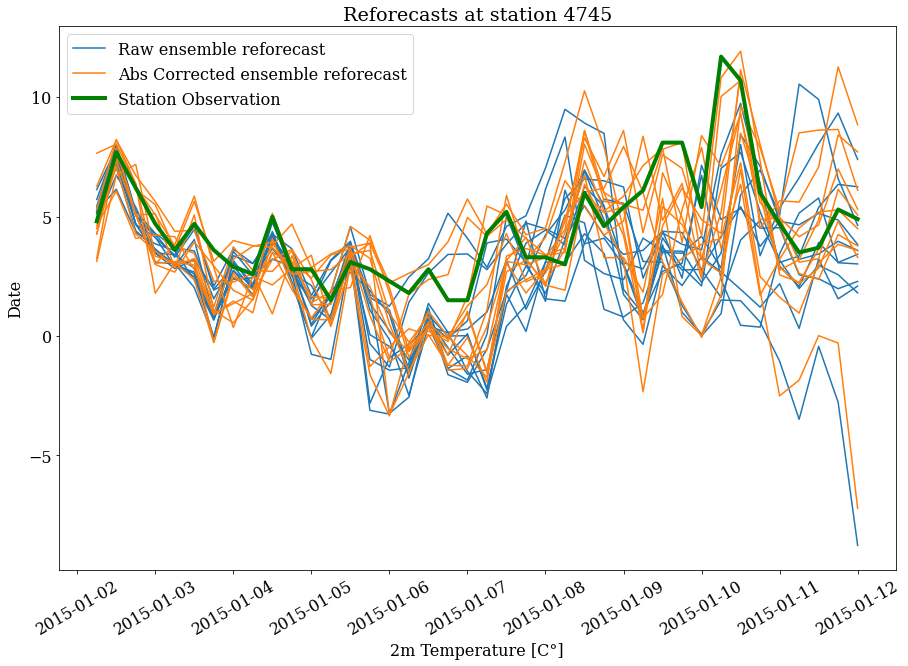Example of station forecasts postprocessing
In this example, using Pythie, we postprocess the 2 metre temperature forecasts at a station. We postprocess it with the 2 metre temperature itself, the maximum 2 metre temperature in the last 6 hours and the soil temperature as predictors.
We use the observation data of the WMO-compliant DWD meteorological station of Soltau from 1997 to 2016. The station is located at the point 52°57’37.5”N, 9°47’35.0”E. The data have been downloaded from the DWD Climate Data Center.
The postprocessing is done by making a regression at each lead time between the reforecasts at a nearby (5.3 km) grid point 53°00’00.0”N, 9°45’00.0”E. For verification, the result of this regression is then applied on the reforecasts themselves (the training set).
The reforecasts at the grid point have been extracted from the reforecasts gridded data available in the gridded reforecasts and reanalysis dataset.
Note: In the following example, we drop the initial conditions of the reforecasts because one of the maximum 2 meter temperature is not defined at this lead time ! As a result, we do not postprocess the lead time 0.
Observation data source
Source: Deutscher Wetterdienst, DWD CDC portal
Reforecast data source
Source: www.ecmwf.int
Creative Commons Attribution 4.0 International (CC BY 4.0) Copyright © 2021 European Centre for Medium-Range Weather Forecasts (ECMWF). See the attached ECMWF_LICENSE.txt file included with the data for more details.
Preliminaries
Setting the path
import sys, os
sys.path.extend([os.path.abspath('../../../../')])
os.chdir('../../../../')
Importing external modules
import matplotlib.pyplot as plt
import numpy as np
import pandas as pd
from matplotlib import rc
rc('font',**{'family':'serif','sans-serif':['Times'],'size':16})
Importing internal modules
from core.data import Data
import postprocessors.MBM as MBM
Setting some parameters
# Date of the forecast
date = "01-02"
# Year to correct
year = 2017
# Number of reforecasts
years_back = 20
# Parameter of the observations (to be postprocessed)
param = '2t'
# Parameters of the predictors
params = ['2t', 'mx2t6', 'stl1']
# Locaction of the data
data_folder = './data/soltau/'
# Station considered
station = 4745
Loading and creating the Data objects
This section shows how to load Data objects from csv files using pandas
Loading the reforecast data
# Temperature
# First create a list of pandas Dataframes from the csv files
reforecasts_temp = list()
for y in range(year-years_back, year):
# note : we skip the first row to drop the forecast initial condition
reforecasts_temp.append(pd.read_csv(data_folder + 'reforecasts_2t_' + str(y) + '-' + date + '_' + str(station) + '.csv', index_col=0, parse_dates=True, skiprows=[1]))
# Then a Data object from this list, loading it along the observation axis, and each member of the list along the member axis
reforecasts_data_2t = Data()
reforecasts_data_2t.load_scalars(reforecasts_temp, load_axis=['obs', 'member'], columns='all')
reforecasts_data_list = list()
reforecasts_data_list.append(reforecasts_data_2t)
# Same for the maximum temperature over the last 6 hours
reforecasts_data_mx2t6 = Data()
reforecasts_mx2t6 = list()
for y in range(year-years_back, year):
# note : we skip the first row to drop the forecast initial condition
reforecasts_mx2t6.append(pd.read_csv(data_folder + 'reforecasts_mx2t6_' + str(y) + '-' + date + '_' + str(station) + '.csv', index_col=0, parse_dates=True, skiprows=[1]))
reforecasts_data_mx2t6.load_scalars(reforecasts_mx2t6, load_axis=['obs', 'member'], columns='all')
reforecasts_data_list.append(reforecasts_data_mx2t6)
# Same for the soil temperature
reforecasts_data_stl1 = Data()
reforecasts_stl1 = list()
for y in range(year-years_back, year):
# note : we skip the first row to drop the forecast initial condition
reforecasts_stl1.append(pd.read_csv(data_folder + 'reforecasts_stl1_' + str(y) + '-' + date + '_' + str(station) + '.csv', index_col=0, parse_dates=True, skiprows=[1]))
reforecasts_data_stl1.load_scalars(reforecasts_stl1, load_axis=['obs', 'member'], columns='all')
reforecasts_data_list.append(reforecasts_data_stl1)
# saving the first predictor (the variable itself) for latter
reforecast_data_1st_predictor = reforecasts_data_list[0].copy()
# Then loading all the predictors into one single Data object
reforecasts_data = reforecasts_data_list[0].copy()
for reforecast in reforecasts_data_list[1:]:
reforecasts_data.append_predictors(reforecast)
Loading the observations corresponding to the reforecast data
# skipping the initial condition of the forecast and taking 6-hourly observations to match the reforecasts timestep
skiprows = lambda x: x==1 or (x != 0 and (x-1) % 6 != 0)
# Temperature
# First create a list of pandas Dataframes from the csv files
past_obs_temp = list()
for y in range(year-years_back, year):
past_obs_temp.append(pd.read_csv(data_folder + 'past_observations_2t_' + str(y) + '-' + date + '_' + str(station) + '.csv', index_col=0, parse_dates=True, skiprows=skiprows))
# Then a Data object from this list, loading it along the observation axis, and each member of the list along the member axis
past_obs_data = Data()
for obs in past_obs_temp:
past_obs_data.load_scalars(obs, load_axis='obs', columns='2t', concat_axis='obs')
Training the PostProcessors
In this section, we train the various different postprocessors of the Member-By-Member MBM module with the data previously loaded
# List to hold the trained PostProcessors
postprocessors = list()
proc_labels = list()
Simple bias correction
ebc = MBM.BiasCorrection()
ebc.train(past_obs_data, reforecasts_data)
postprocessors.append(ebc)
proc_labels.append('Bias correction')
Ensemble Mean correction
emc = MBM.EnsembleMeanCorrection()
emc.train(past_obs_data, reforecasts_data)
postprocessors.append(emc)
proc_labels.append('Ensemble Mean correction')
Ensemble Spread Scaling correction
essc = MBM.EnsembleSpreadScalingCorrection()
essc.train(past_obs_data, reforecasts_data)
postprocessors.append(essc)
proc_labels.append('Ensemble Spread Scaling correction')
Ensemble Spread Scaling correction with Absolute norm CRPS minimization
essacc = MBM.EnsembleSpreadScalingAbsCRPSCorrection()
essacc.train(past_obs_data, reforecasts_data, ntrial=10)
postprocessors.append(essacc)
proc_labels.append('Ensemble Spread Scaling Abs. CRPS min. correction')
Ensemble Spread Scaling correction + Climatology nudging with Absolute norm CRPS minimization
eacc = MBM.EnsembleAbsCRPSCorrection()
eacc.train(past_obs_data, reforecasts_data, ntrial=10)
postprocessors.append(eacc)
proc_labels.append('Ensemble Spread Scaling + Clim. Nudging Abs. CRPS min. correction')
Ensemble Spread Scaling correction + Climatology nudging with Ngr CRPS minimization
encc = MBM.EnsembleNgrCRPSCorrection()
encc.train(past_obs_data, reforecasts_data, ntrial=10)
postprocessors.append(encc)
proc_labels.append('Ensemble Spread Scaling + Clim. Nudging Ngr CRPS min. correction')
Verification
Here we are going to postprocess the reforecasts themselves to see how well they perform:
# List to store the experiment names
exp_results = list()
exp_results.append(reforecast_data_1st_predictor)
exp_labels = list()
exp_labels.append('Raw forecasts')
timestamps = np.array(range(reforecast_data_1st_predictor.number_of_time_steps))
for label, postprocessor in zip(proc_labels, postprocessors):
exp_results.append(postprocessor(reforecasts_data))
exp_labels.append(label)
Computing scores
Computing the bias
# List to store the CRPS Data object
bias = list()
for label, result in zip(exp_labels, exp_results):
bias.append(result.bias(past_obs_data))
Computing the ensemble mean RMSE
# List to store the CRPS Data object
rmse = list()
for label, result in zip(exp_labels, exp_results):
rmse.append(result.ensemble_mean_RMSE(past_obs_data))
Computing the CRPS
# List to store the CRPS Data object
crps = list()
for label, result in zip(exp_labels, exp_results):
crps.append(result.CRPS(past_obs_data))
Plotting the scores
fig = plt.figure(figsize=(15,10))
ax = fig.gca()
first = True
for c, lab in zip(crps, exp_labels):
if first:
c.plot(ax=ax, global_label=lab, timestamps=timestamps, lw=3., ls="--")
first = False
else:
c.plot(ax=ax, global_label=lab, timestamps=timestamps)
ax.legend()
ax.set_title('CRPS Score at station '+str(station))
ax.set_ylabel('CRPS [C°]')
ax.set_xlabel('time x 6hrs');
ax.set_ylim(0., 3.5);
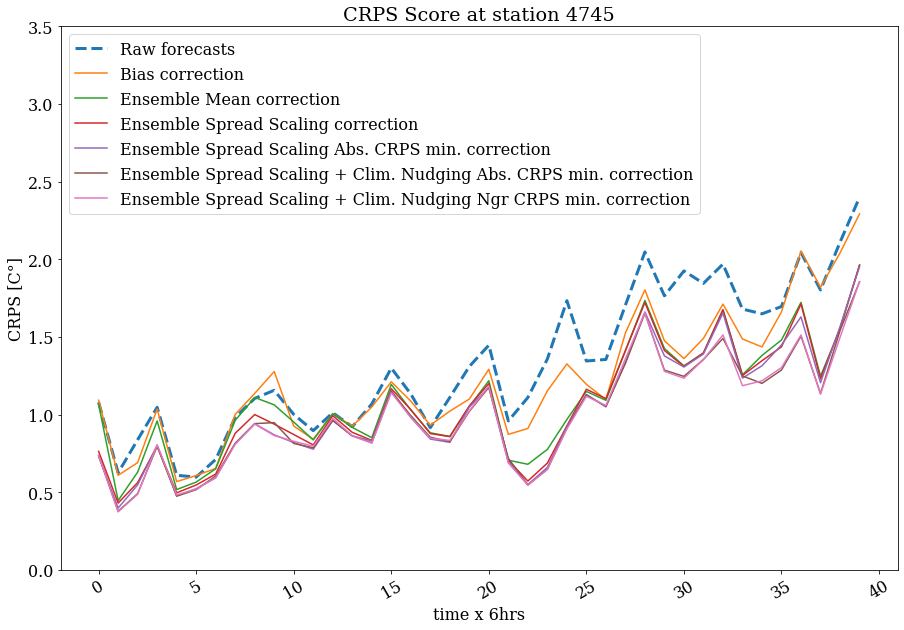
fig = plt.figure(figsize=(15,10))
ax = fig.gca()
first = True
for c, lab in zip(rmse, exp_labels):
if first:
c.plot(ax=ax, global_label=lab, timestamps=timestamps, lw=3., ls="--")
first = False
else:
c.plot(ax=ax, global_label=lab, timestamps=timestamps)
ax.legend()
ax.set_title('RMSE Score at station '+str(station))
ax.set_ylabel('RMSE [C°]')
ax.set_xlabel('time x 6hrs');
ax.set_ylim(0., 5.5);
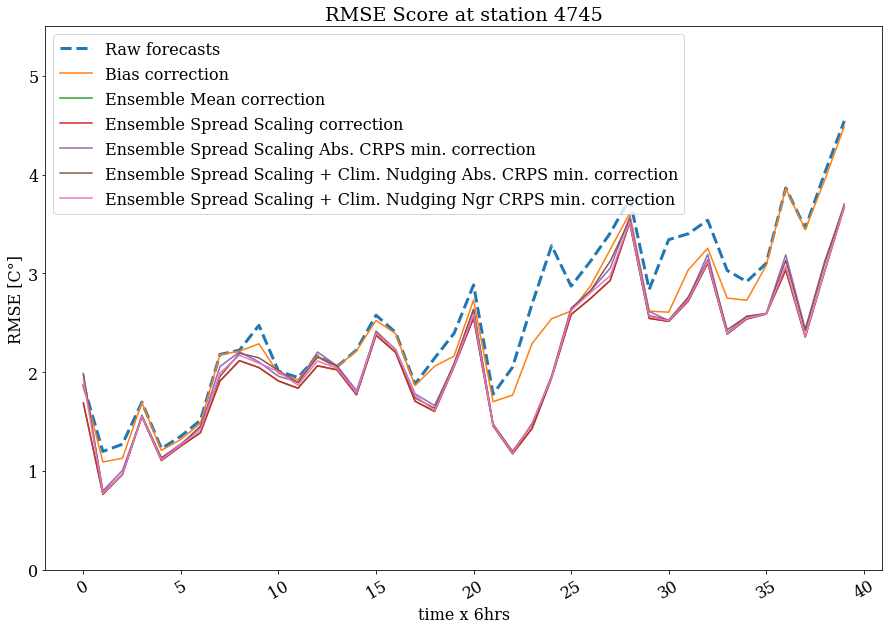
fig = plt.figure(figsize=(15,10))
ax = fig.gca()
first = True
for c, lab in zip(bias, exp_labels):
if first:
c.plot(ax=ax, global_label=lab, timestamps=timestamps, lw=3., ls="--")
first = False
else:
c.plot(ax=ax, global_label=lab, timestamps=timestamps)
ax.legend()
ax.set_title('Bias at station '+str(station))
ax.set_ylabel('Bias [C°]')
ax.set_xlabel('time x 6hrs');
ax.set_ylim(-3., 1.);
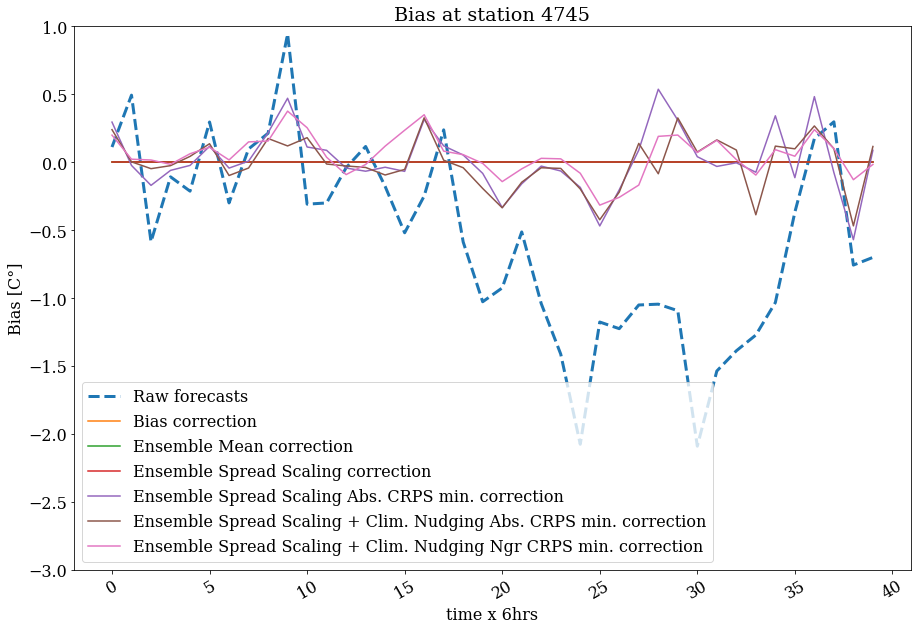
Example of a postprocessing parameters plot
fig = plt.figure(figsize=(15,10))
ax = fig.gca()
postprocessors[-2].plot_parameters(ax=ax);
ax.set_ylim(-8.,8.)
ax.set_xlabel('Timestep [hours]')
ax.set_title('Postprocessing parameters\n('+exp_labels[-2]+')');
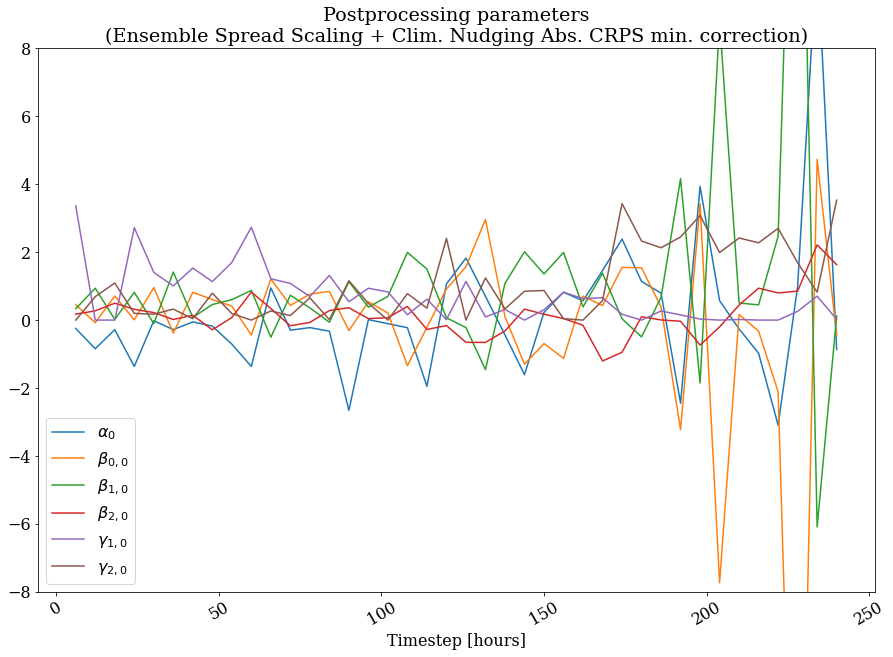
Example of a reforecast plot
a = Data(reforecast_data_1st_predictor[0,-2][np.newaxis, np.newaxis,...], timestamps=[reforecast_data_1st_predictor.timestamps[0,-2]])
b = Data(exp_results[-1][0,-2][np.newaxis, np.newaxis,...], timestamps=[reforecast_data_1st_predictor.timestamps[0,-2]])
bb = Data(exp_results[-2][0,-2][np.newaxis, np.newaxis,...], timestamps=[reforecast_data_1st_predictor.timestamps[0,-2]])
c = Data(past_obs_data[0,-2][np.newaxis, np.newaxis,...], timestamps=[past_obs_data.timestamps[0,-2]])
fig = plt.figure(figsize=(15,10))
ax = fig.gca()
a.plot(color='tab:blue', ax=ax, global_label='Raw ensemble reforecast')
b.plot(color='tab:orange', ax=ax, global_label='Ngr Corrected ensemble reforecast')
c.plot(color='g', ax=ax, label='Station Observation', lw=4.)
ax.set_title('Reforecasts at station '+str(station))
ax.set_ylabel('Date')
ax.set_xlabel('2m Temperature [C°]')
ax.legend();
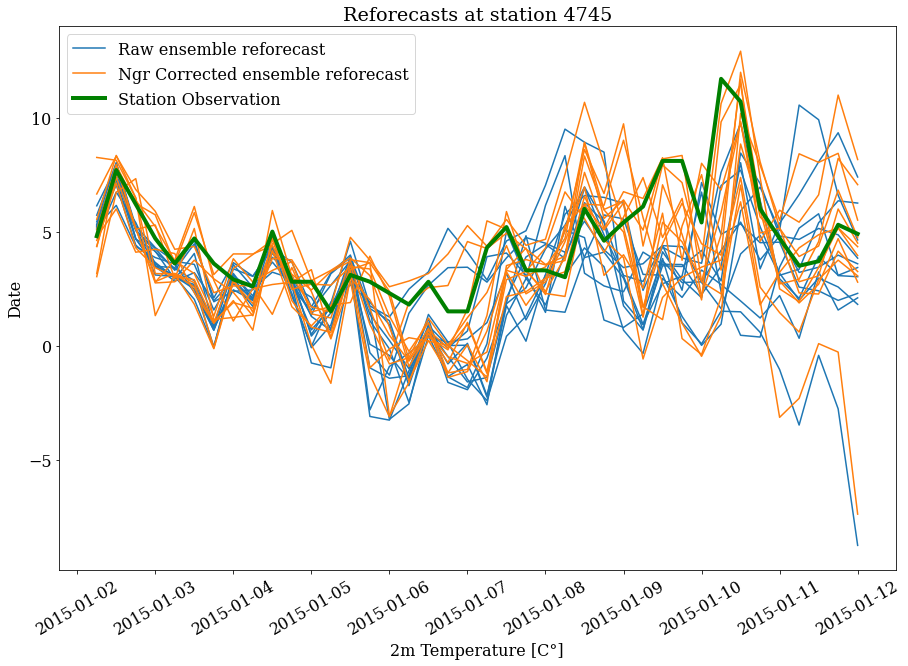
fig = plt.figure(figsize=(15,10))
ax = fig.gca()
a.plot(color='tab:blue', ax=ax, global_label='Raw ensemble reforecast')
bb.plot(color='tab:orange', ax=ax, global_label='Abs Corrected ensemble reforecast')
c.plot(color='g', ax=ax, label='Station Observation', lw=4.)
ax.set_title('Reforecasts at station '+str(station))
ax.set_ylabel('Date')
ax.set_xlabel('2m Temperature [C°]')
ax.legend();
